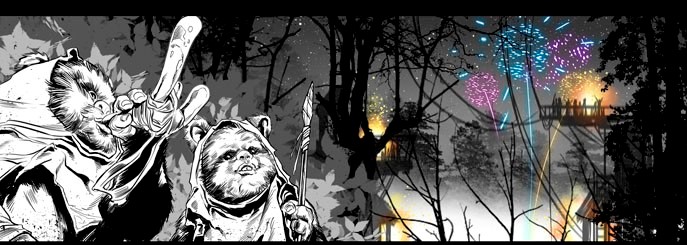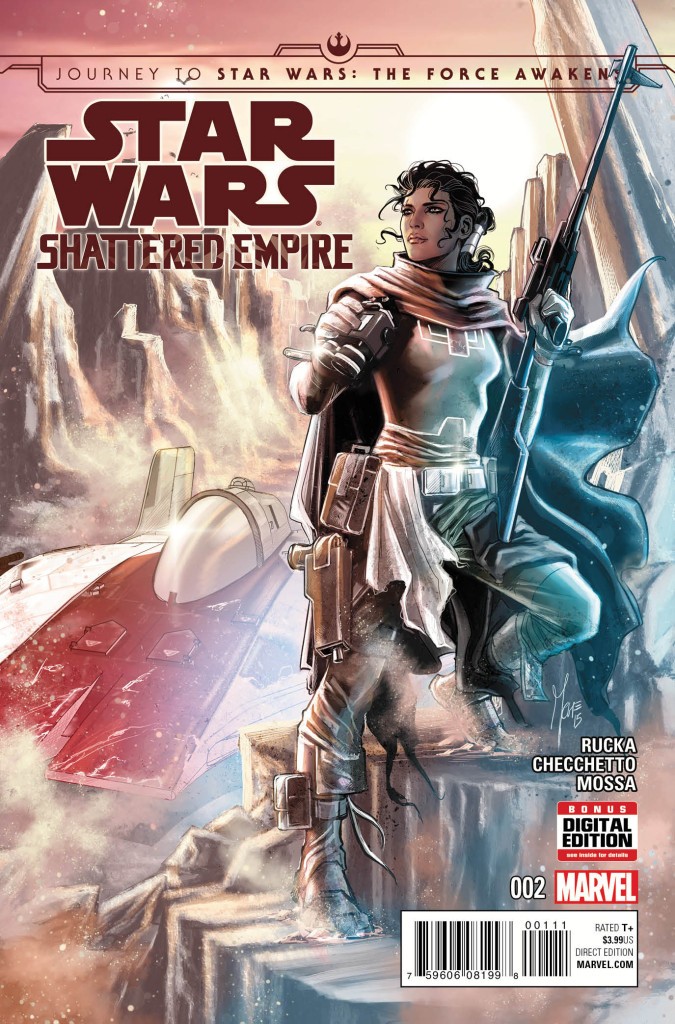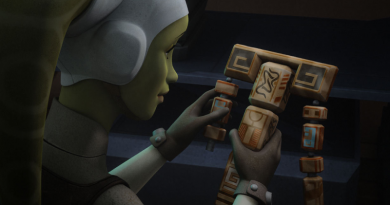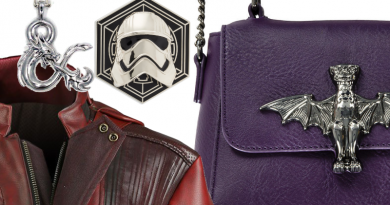Shattered Empire: What I Am Most Excited To Read
Last month, Dan Brooks of StarWars.com interviewed Greg Rucka about his upcoming four-issue mini-series Star Wars: Shattered Empire. According to the article, the Marvel comic will be a “tentpole story in the Journey to the Star Wars: The Force Awakens publishing program.” Although introduced with the beautiful Phil Noto art harking back to the closing moments of Return of the Jedi, Shattered Empire “follows new characters Kes and main protagonist Shara Brey – husband and wife Rebels – as the struggle for freedom continues” after the Battle of Endor.
 Rucka says, “When you’re young and you see Jedi you can look at the happy ending and go, ‘Hey, it’s over!’ But you get older and you start to think about it, and you realize, no it’s not. It’s not over at all.”
Rucka says, “When you’re young and you see Jedi you can look at the happy ending and go, ‘Hey, it’s over!’ But you get older and you start to think about it, and you realize, no it’s not. It’s not over at all.”
That moment beyond the presumed triumphant ending of Episode VI is the stuff of legend – and Legends, though those more familiar with the Expanded Universe often forget that a majority of Star Wars fans’ experiences ended with the second Death Star destroyed, Luke having redeemed his father, and Ewoks partying hard. A four-part comic is a simple way to get the masses reconsidering their presumptions about the state of the galaxy.
 Anyone who has read the adult novelizations might find something familiar in Rucka’s description of his central characters:
Anyone who has read the adult novelizations might find something familiar in Rucka’s description of his central characters:
Shara flies, Kes is a ground-pounder, and a very experienced one. So, they have spent more time apart than together, and they’re in the Outer Rim world where the Imperial presence is felt, and they’re hoping that they can bring an end to this. But they’re both very tired veterans.
There is something very familiar about Shara and Kes…
 Back in 2012, I had the chance to ask fan-favorite author Aaron Allston about one of my favorite characters, Tyria Sarkin, who had been part of the roster in Wraith Squadron. I embraced Tyria for many reasons: she was a pilot, she struggled as a rather ordinary contributor to the war effort, she was a woman who could handle herself around men. She finally found love with fellow Wraith Kell Tainer, who she married, had kids with, and lived apart from as the post-Endor battle for the galaxy progressed endlessly. Allston, a fan of soap operas, seemed to be the one author in the waning years of the Expanded Universe who understood that even average characters needed milestones, that Star Wars couldn’t always be about birthrights, destiny, revenge, and death. More importantly, Allston understood that readers need milestones beyond just blowing up Death Stars or destroying inscrutable big bads such as Abeloth.
Back in 2012, I had the chance to ask fan-favorite author Aaron Allston about one of my favorite characters, Tyria Sarkin, who had been part of the roster in Wraith Squadron. I embraced Tyria for many reasons: she was a pilot, she struggled as a rather ordinary contributor to the war effort, she was a woman who could handle herself around men. She finally found love with fellow Wraith Kell Tainer, who she married, had kids with, and lived apart from as the post-Endor battle for the galaxy progressed endlessly. Allston, a fan of soap operas, seemed to be the one author in the waning years of the Expanded Universe who understood that even average characters needed milestones, that Star Wars couldn’t always be about birthrights, destiny, revenge, and death. More importantly, Allston understood that readers need milestones beyond just blowing up Death Stars or destroying inscrutable big bads such as Abeloth.
Over the years I have been critical of Star Wars’ inability to grow up, allow characters to have lives, romantic successes and failures, and ultimately to show the real impact war has on friendships and families. Even some of the more recent additions to the adult novelizations, Heir to the Jedi and Dark Disciple, handled romance with the deftness of middle-grade storytelling.
Interestingly, in my interview with Allston the list of writers who I felt handled female characters well included Greg Rucka. I’ve been watching his career with interest over the years, noting his thoughts on balancing the grim realities of superhero stories and writing strong female characters. In his amazing article “Why I Write Strong Female Characters,” Rucka rolls up his sleeves and gets real down and dirty on the topic of women in fiction. The whole article is worth the read, but this part struck me:
Writers don’t write Men or Women or Dogs or Salmon. Writers write characters, and at our best, if we do it well and with care and with thought, we invest in those characters a spark of life, a realism and nuance that makes them believable and relatable. We seek to craft characters who inspire empathy, characters our audience will care for, and as a result, will care about what happens to them, and thus will share the journey we have charted. A story, after all, is the character’s journey.
No character – no well-created character, at least – is defined by only one trait, by one aspect. Sherlock Holmes is not simply brilliant. He’s also a malfunctioning human being who, perhaps ironically, possesses a strong moral compass and such a compulsion to pursue justice that it eclipses any fealty to the law. He’s also a junkie.
Harry Potter is not the scar on his forehead, nor is Matthew Scudder solely an alcoholic, nor is V.I. Warshawski just a “female” private detective. Character is biology, countless cells and processes, many of them invisible to the naked eye, yet together forming a whole. A character’s gender, like their religious upbringing or their faith, like their favorite book or food, like their sexual orientation and experiences, like their education and their childhood, is a component of character.
That said, some components certainly weigh heavier than others. Green eyes don’t tend to affect character, unless that story is Big Trouble in Little China, for instance. But to define any character by gender alone makes about as much sense as defining a character by hair-color, or – ahem – judging a book by its cover.
 I am excited for many of the Journey to The Force Awakens books, including Chuck Wendig’s Aftermath and Claudia Gray’s Lost Stars. Marvel has been making quarterly trips to Lucasfilm and is ahead of the curve when it comes to producing interconnective canon. That’s why I believe Shattered Empire will be the most important piece of storytelling to launch in the coming weeks. On the latest episode of Fangirl Chat, Teresa Delgado and I both agreed we will be starting with Lost Stars, while we wait for Shattered Empire to roll out over the coming weeks.
I am excited for many of the Journey to The Force Awakens books, including Chuck Wendig’s Aftermath and Claudia Gray’s Lost Stars. Marvel has been making quarterly trips to Lucasfilm and is ahead of the curve when it comes to producing interconnective canon. That’s why I believe Shattered Empire will be the most important piece of storytelling to launch in the coming weeks. On the latest episode of Fangirl Chat, Teresa Delgado and I both agreed we will be starting with Lost Stars, while we wait for Shattered Empire to roll out over the coming weeks.
In the meantime, check out some of the amazing variants available for Issue #1 shared by Rucka on his Tumblr and the cover of Shattered Empire #2, where the scar over Kes’s right eye is even more noticeable, and reminds me of another favorite Expanded Universe character, Jagged Fel.

Tricia Barr took her understanding of brand management and marketing, mixed it with a love of genre storytelling, and added a dash of social media flare to create FANgirl Blog, where she discusses Star Wars, fandom, and strong female characters. She is one of four authors of Ultimate Star Wars from DK Publishing, has written several feature articles for Star Wars Insider magazine and is a contributor for Her Universe’s Year of the Fangirl. Her FANgirl opinions can be heard on the podcasts Hyperspace Theories and RebelForce Radio Presents Fangirls Going Rogue.
Tricia Barr’s novel, Wynde, won the 2014 Independent Publisher Book Award Gold Medal for Best Science Fiction/Fantasy/Horror Ebook. She was also part of Silence in the Library’s successful all-female creator science fiction and fantasy anthology Athena’s Daughters, which is available now. For excerpts and tales of her adventures in creating a fictional universe, hop over to TriciaBarr.com.
For updates on all things FANgirl follow @FANgirlcantina on Twitter or like FANgirl Zone on Facebook. At times she tries the Tumblr.
- Hyperspace Theories: SKELETON CREW Ahoy! - December 29, 2024
- Hyperspace Theories: WICKED Part I Rises to the Moment - December 6, 2024
- Columbia’s Vader™ Collection Launches Dec 5 - November 27, 2024










